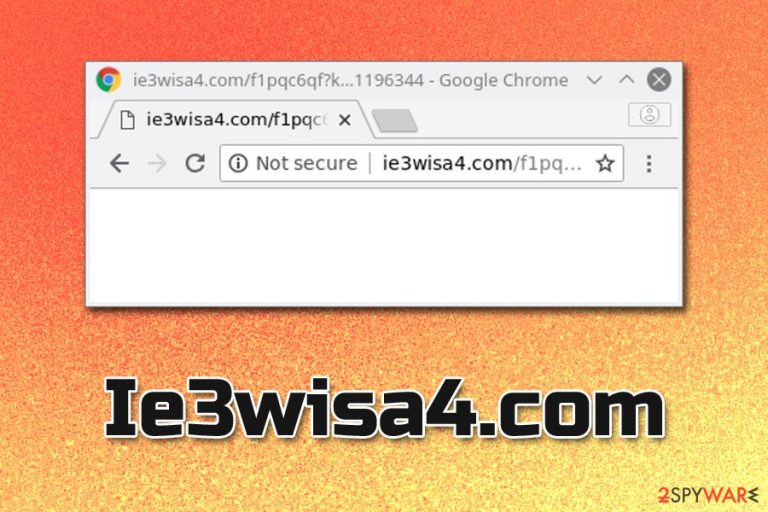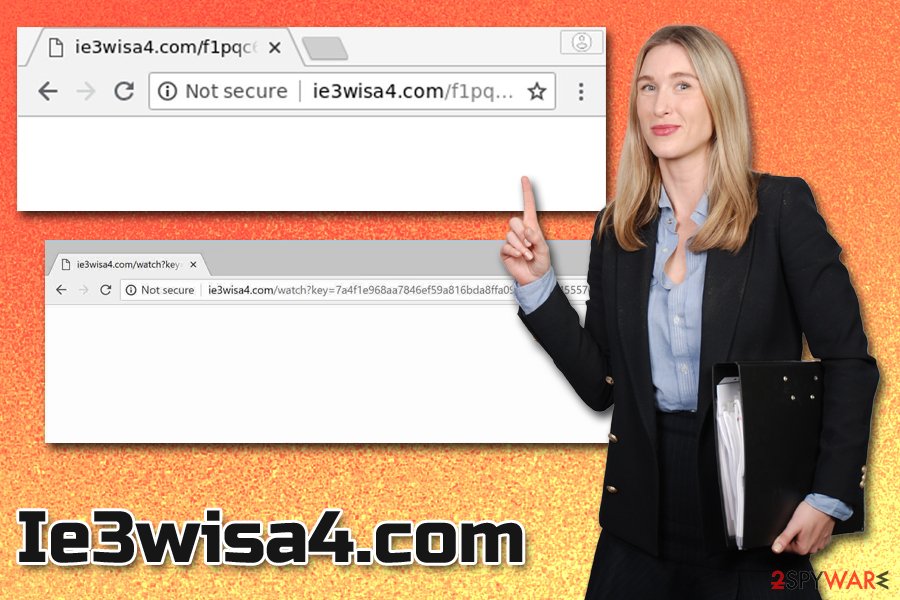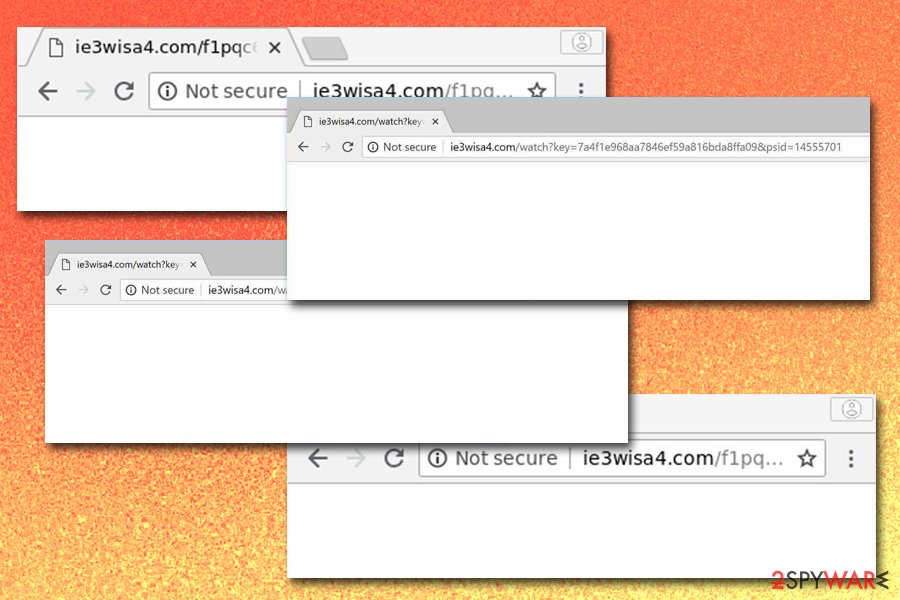Ie3wisa4.com (Removal Guide) - updated Jan 2020
Ie3wisa4.com Removal Guide
What is Ie3wisa4.com?
Ie3wisa4 is a deceptive domain that used to display Android and computer users intrusive ads and redirect them to dubious sites

Ie3wisa4 is a redirect virus that users might encounter on their Android devices, desktop computers, as well as Macs when browsing the internet. The domain is often used by potentially unwanted programs like adware[1] to redirect users to unknown sites that push pop-ups, deals, offers, banners, hyperlinks, and other sponsored content.
The intrusive advertisement content can appear on various browsers, such as Google Chrome, Internet Explorer, Safari, Mozilla Firefox, Opera, and others. Nevertheless, the activity of Ie3wisa4.com can be isolated to a particular browser or affect all the installed ones.
Ie3wisa4 virus behavior depends on the type of adware that is installed; for example, if the unwanted ads are only prevalent in one of the browsers, it is highly likely that the culprit is browser plugin or extension. In contrary, the widespread operation means that adware application is installed on the computer. In such a case, to remove Ie3wisa4.com redirects, users will have to uninstall the app that is causing the unwanted activity.
| Name | Ie3wisa4 |
| Type | Adware |
| Affected operating systems | Windows, macOS, Android |
| Infiltration means | Software bundles, third-party websites |
| Risks | Malware infections, money loss, sensitive information disclosure to unknown parties, etc. |
| Symptoms | Intrusive redirects to one of Ie3wisa4.com subdomains during web browsing; increased amount of ads on all sites |
| Removal | Scan your device with anti-malware software or delete the adware app manually using our instructions below |
| Recovery | To make sure your computer is back to normal and virus damage is removed, scan it with FortectIntego |
Adware, initially regarded as “spyware,” managed to get a “not-a-virus”[2] title over the years and labeled as potentially unwanted. However, the growing concerns over the safety of such software from security community served as a wake-up call: ads served by adware are not always safe, and users might compromise their online safety when they get redirected to domains like Ie3wisa4.com.
Besides seeing intrusive ads, Ie3wisa4.com redirects can also bring users to spoofing,[3] phishing and tech support scam sites, which will try to mislead people either installing bogus software like Advanced Mac Cleaner or paying for bogus tech support services. Consequently, users can lose a large amount of money or end up installing other PUPs that might even harm their devices.
Finally, the presence of Ie3wisa4 also means that unknown parties are tracking your online activities, and the following data is harvested:
- IP address
- Geolocation
- Search terms
- Sites visited
- Links clicked
- Duration of the visit
- Technical data, etc.

While this information does not identify you personally, you should not allow third-parties to scrutinize your online behavior, as it might bring to privacy issues.
You should proceed with Ie3wisa4 removal either by using security software or our manual guide below.
Adware can be downloaded intentionally, although it usually travels within software bundles
Adware is a sneaky type of software that usually gets installed together with other free programs from the internet, such as media players, file converters, download managers, browser extensions, etc. This happens because developers of freeware and shareware strike a deal with adware authors and bundle programs in one installer package. For every additional install, developers of free programs receive payments, so it is in their best interest to make as many users as possible to install unwanted applications.
However, you don't need to be a PC expert to avoid such installations. All you have to do is pay more attention when installing new software. First of all, you should always make sure that it is coming from a reputable source and never download software from torrent and similar sites. Also, during the installation process, make sure you decline all the deals and offers on the way, and opt for Advanced/Custom settings so you can remove ticks next to unwanted programs.
Finally, do not be deceived by the functionality of some apps – usually, they are entirely useless and will not meet the expectations but will only flood you with ads and disturb your web browsing sessions.
Stop Ie3wisa4.com redirects and other intrusive behavior
To remove Ie3wisa4.com virus from your computer, you will have to either scan it with reputable anti-virus software that specializes in potentially unwanted program removal or terminate it manually using our guide below. If you pick the latter, make sure you follow the steps accurately, or the process will fail.

As soon as you are positive that Ie3wisa4.com removal is successful, you should also reset all the installed browsers on your computer. We explain how to do that on desktops below. Nevertheless, if your Android is suffering from disruptive behavior, you should scan it with anti-virus software or check out the installed app list to determine the unwanted application and uninstall it.
You may remove virus damage with a help of FortectIntego. SpyHunter 5Combo Cleaner and Malwarebytes are recommended to detect potentially unwanted programs and viruses with all their files and registry entries that are related to them.
Getting rid of Ie3wisa4.com. Follow these steps
Uninstall from Windows
If Windows OS is suffering from intrusive advertisements on Ie3wisa4.com domain, make sure you perform the following steps:
Instructions for Windows 10/8 machines:
- Enter Control Panel into Windows search box and hit Enter or click on the search result.
- Under Programs, select Uninstall a program.

- From the list, find the entry of the suspicious program.
- Right-click on the application and select Uninstall.
- If User Account Control shows up, click Yes.
- Wait till uninstallation process is complete and click OK.

If you are Windows 7/XP user, proceed with the following instructions:
- Click on Windows Start > Control Panel located on the right pane (if you are Windows XP user, click on Add/Remove Programs).
- In Control Panel, select Programs > Uninstall a program.

- Pick the unwanted application by clicking on it once.
- At the top, click Uninstall/Change.
- In the confirmation prompt, pick Yes.
- Click OK once the removal process is finished.
Delete from macOS
Mac users should follow this guide in order to remove pop-ups from their browsers:
Remove items from Applications folder:
- From the menu bar, select Go > Applications.
- In the Applications folder, look for all related entries.
- Click on the app and drag it to Trash (or right-click and pick Move to Trash)

To fully remove an unwanted app, you need to access Application Support, LaunchAgents, and LaunchDaemons folders and delete relevant files:
- Select Go > Go to Folder.
- Enter /Library/Application Support and click Go or press Enter.
- In the Application Support folder, look for any dubious entries and then delete them.
- Now enter /Library/LaunchAgents and /Library/LaunchDaemons folders the same way and terminate all the related .plist files.

Remove from Microsoft Edge
Do not forget to reset Internet Explorer as soon as you eliminate the unwanted app:
Delete unwanted extensions from MS Edge:
- Select Menu (three horizontal dots at the top-right of the browser window) and pick Extensions.
- From the list, pick the extension and click on the Gear icon.
- Click on Uninstall at the bottom.

Clear cookies and other browser data:
- Click on the Menu (three horizontal dots at the top-right of the browser window) and select Privacy & security.
- Under Clear browsing data, pick Choose what to clear.
- Select everything (apart from passwords, although you might want to include Media licenses as well, if applicable) and click on Clear.

Restore new tab and homepage settings:
- Click the menu icon and choose Settings.
- Then find On startup section.
- Click Disable if you found any suspicious domain.
Reset MS Edge if the above steps did not work:
- Press on Ctrl + Shift + Esc to open Task Manager.
- Click on More details arrow at the bottom of the window.
- Select Details tab.
- Now scroll down and locate every entry with Microsoft Edge name in it. Right-click on each of them and select End Task to stop MS Edge from running.

If this solution failed to help you, you need to use an advanced Edge reset method. Note that you need to backup your data before proceeding.
- Find the following folder on your computer: C:\\Users\\%username%\\AppData\\Local\\Packages\\Microsoft.MicrosoftEdge_8wekyb3d8bbwe.
- Press Ctrl + A on your keyboard to select all folders.
- Right-click on them and pick Delete

- Now right-click on the Start button and pick Windows PowerShell (Admin).
- When the new window opens, copy and paste the following command, and then press Enter:
Get-AppXPackage -AllUsers -Name Microsoft.MicrosoftEdge | Foreach {Add-AppxPackage -DisableDevelopmentMode -Register “$($_.InstallLocation)\\AppXManifest.xml” -Verbose

Instructions for Chromium-based Edge
Delete extensions from MS Edge (Chromium):
- Open Edge and click select Settings > Extensions.
- Delete unwanted extensions by clicking Remove.

Clear cache and site data:
- Click on Menu and go to Settings.
- Select Privacy, search and services.
- Under Clear browsing data, pick Choose what to clear.
- Under Time range, pick All time.
- Select Clear now.

Reset Chromium-based MS Edge:
- Click on Menu and select Settings.
- On the left side, pick Reset settings.
- Select Restore settings to their default values.
- Confirm with Reset.

Remove from Mozilla Firefox (FF)
Remove dangerous extensions:
- Open Mozilla Firefox browser and click on the Menu (three horizontal lines at the top-right of the window).
- Select Add-ons.
- In here, select unwanted plugin and click Remove.

Reset the homepage:
- Click three horizontal lines at the top right corner to open the menu.
- Choose Options.
- Under Home options, enter your preferred site that will open every time you newly open the Mozilla Firefox.
Clear cookies and site data:
- Click Menu and pick Settings.
- Go to Privacy & Security section.
- Scroll down to locate Cookies and Site Data.
- Click on Clear Data…
- Select Cookies and Site Data, as well as Cached Web Content and press Clear.

Reset Mozilla Firefox
If clearing the browser as explained above did not help, reset Mozilla Firefox:
- Open Mozilla Firefox browser and click the Menu.
- Go to Help and then choose Troubleshooting Information.

- Under Give Firefox a tune up section, click on Refresh Firefox…
- Once the pop-up shows up, confirm the action by pressing on Refresh Firefox.

Remove from Google Chrome
Delete malicious extensions from Google Chrome:
- Open Google Chrome, click on the Menu (three vertical dots at the top-right corner) and select More tools > Extensions.
- In the newly opened window, you will see all the installed extensions. Uninstall all the suspicious plugins that might be related to the unwanted program by clicking Remove.

Clear cache and web data from Chrome:
- Click on Menu and pick Settings.
- Under Privacy and security, select Clear browsing data.
- Select Browsing history, Cookies and other site data, as well as Cached images and files.
- Click Clear data.

Change your homepage:
- Click menu and choose Settings.
- Look for a suspicious site in the On startup section.
- Click on Open a specific or set of pages and click on three dots to find the Remove option.
Reset Google Chrome:
If the previous methods did not help you, reset Google Chrome to eliminate all the unwanted components:
- Click on Menu and select Settings.
- In the Settings, scroll down and click Advanced.
- Scroll down and locate Reset and clean up section.
- Now click Restore settings to their original defaults.
- Confirm with Reset settings.

Delete from Safari
Remove unwanted extensions from Safari:
- Click Safari > Preferences…
- In the new window, pick Extensions.
- Select the unwanted extension and select Uninstall.

Clear cookies and other website data from Safari:
- Click Safari > Clear History…
- From the drop-down menu under Clear, pick all history.
- Confirm with Clear History.

Reset Safari if the above-mentioned steps did not help you:
- Click Safari > Preferences…
- Go to Advanced tab.
- Tick the Show Develop menu in menu bar.
- From the menu bar, click Develop, and then select Empty Caches.

After uninstalling this potentially unwanted program (PUP) and fixing each of your web browsers, we recommend you to scan your PC system with a reputable anti-spyware. This will help you to get rid of Ie3wisa4.com registry traces and will also identify related parasites or possible malware infections on your computer. For that you can use our top-rated malware remover: FortectIntego, SpyHunter 5Combo Cleaner or Malwarebytes.
How to prevent from getting adware
Access your website securely from any location
When you work on the domain, site, blog, or different project that requires constant management, content creation, or coding, you may need to connect to the server and content management service more often. The best solution for creating a tighter network could be a dedicated/fixed IP address.
If you make your IP address static and set to your device, you can connect to the CMS from any location and do not create any additional issues for the server or network manager that needs to monitor connections and activities. VPN software providers like Private Internet Access can help you with such settings and offer the option to control the online reputation and manage projects easily from any part of the world.
Recover files after data-affecting malware attacks
While much of the data can be accidentally deleted due to various reasons, malware is one of the main culprits that can cause loss of pictures, documents, videos, and other important files. More serious malware infections lead to significant data loss when your documents, system files, and images get encrypted. In particular, ransomware is is a type of malware that focuses on such functions, so your files become useless without an ability to access them.
Even though there is little to no possibility to recover after file-locking threats, some applications have features for data recovery in the system. In some cases, Data Recovery Pro can also help to recover at least some portion of your data after data-locking virus infection or general cyber infection.
- ^ Margaret Rouse. Adware. SearchSecurity. Information Security information, news and tips.
- ^ Alex Perekalin. Not-a-Virus: What is it?. Kaspersky Daily. Official blog.
- ^ Website spoofing. Wikipedia. The free encyclopedia.
